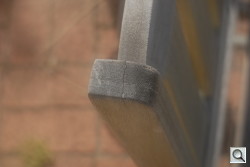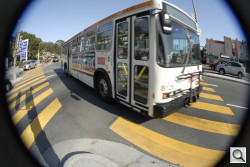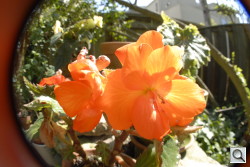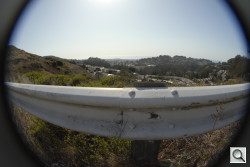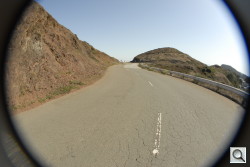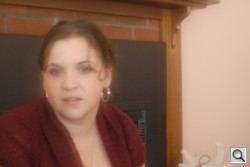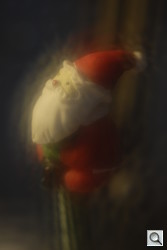CIGARS ALL AROUND
Lensbaby Adds Two
To Optic Swap System
By MIKE PASINI
Editor
The Imaging Resource Digital Photography Newsletter
Review Date: October 2009
Stand in line for the cigars. Lensbaby has expanded its Optic Swap system with two new additions. While they aren't identical twins, the Fisheye optic and Soft Focus optic will change the perspective of anyone who adopts them.
The company made a name for itself with its selective focus lens designs, now in their third generation with the Composer. The two new optics both extend focus evenly over the frame, unlike their siblings, but still slip into the Composer lens housing like any of the others. With an adapter you can pop the Fisheye into the Muse, too. And Soft Focus is compatible with both the Muse and the Control Freak.
The additions expand the Optic Swap System into new areas, offering two creative effects not easily achieved with your dSLR manufacturer's lens system. There's no doubt a fisheye option in that lens list, but not as affordable as this one. And while there are plenty of tricks for achieving soft focus (like stretching some pantyhose over the lens or smearing a filter with grease), they all take more effort than using the Soft Focus optic.
Lensbaby offered us the chance to babysit the new brood for a couple of weeks before they made their debut at PhotoPlus Expo. We had a ball.
CHANGING PERSPECTIVE | Back to Contents
While the temptation is strong to buy an 18-200mm zoom lens for your dSLR and be done with it, the real fun of using a camera that can function with different lenses is, well, to change the optics.
It's refreshing to swap out that all-purpose zoom for a 35mm prime or even a 50mm prime with a 2x extender on it. Or just put a reversing ring on that 50mm to shoot some macro shots.
You quickly begin to see things differently and are forced to compose your shots with your feet instead of the zoom ring.
The Lensbaby Optic Swap System takes that to a new dimension with what has just become a range of six specialty lenses. The selective focus line featuring Double Glass, Single Glass and Plastic optics offers various qualities of blur while the new Fisheye and Soft Focus optics join the Pinhole/Zone optic to provide even more effects.
The interchangeable optics can be swapped in and out of the Muse, Composer and Control Freak. The selective focus optics have a curved field of focus to vary depth of field by creating a movable sweet spot of sharp focus surrounded by charming blur. The Fisheye, Soft Focus and Pinhole/Zone plate optics feature a flat field of focus to create their distinctive rendering of the scene.
All of them are housed in a single lens body. In our case, we shot with the Composer. The Composer was designed to make it easy to both swivel the optic to move the sharper area of the selective focus optics around the frame and to freeze the focus spot.
It takes some care to align the Composer for either the Fisheye or the Soft Focus optic. The flexibility that makes it easy to use the soft focus optics off-center doesn't easily center itself when you put the two new optics in the Composer. They're designed to be centered, not swiveled. The Fisheye should have even borders. And Soft Focus can be confusing if the center isn't in focus.
You have to align by eye in the viewfinder (rather than align the lens so it looks straight on the body). Of course, you can crop later, but take a few minutes to set the Composer, test it by downloading an image or two and lock the position before you rely on it.
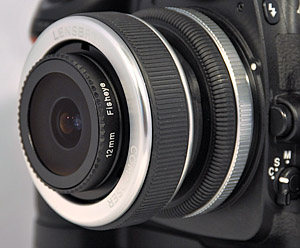
Fisheye. A 160-degree view of the world at 12mm.
The $149.95 six element multi-coated Fisheye optic is a lot of fun. Lensbaby told us it offers approximately a 160 degree view of the world. That's not quite the 180 degrees of those fabulously expensive optics your camera manufacturer may offer, but it does have the advantage of sitting behind a piece of optical glass to protect it.
It does not, however, accept a lens cap. And that was a problem for us when we wanted to toss the camera in a bag and take a trip across the bay to shoot some fisheye shots of Berkeley. We really didn't have time to think of a way to protect the front element before we had to leave. So the opportunity was lost.
One solution is to just leave the Fisheye in its case and take a selective focus optic along, then swap them out when you're ready to shoot. And no doubt, you can fashion your own lens cap for it, too.
Like the Double Glass, Single Glass, and Plastic optics in the system, the Fisheye is designed to be used in Manual or Aperture Priority mode. Almost everything we shot was in Aperture Priority mode so we could focus on composition.
And also like the other elements, the Fisheye comes with a set of aperture discs to control the amount of light getting to the sensor. With a focal length as wide as 12mm, they really didn't seem to have any effect on depth of field. But if you are shooting close-ups, stopping down can't hurt. Discs ranging from f/4 to f/22 are provided.
To change apertures, you unscrew the top element of the Fisheye optic itself from its body (it's a two-piece element) and drop or place the aperture disc into the well. The disc holder has a simple tool to make it easy to place or remove a disc. Strong magnets grab it before it falls through, aligning it perfectly. Then screw the lens back in. It seemed to sit a bit further out, coming in contact, we suspect, with the back of the lens (although not touching any glass). But that had no affect on performance.
Our first shots were wide open but then we dropped in an f/11 aperture disc and used that.
Shooting with the Fisheye was a blast. It's a gregarious lens, embracing the whole world so you hardly have to aim your camera. That makes it less helpful for narrowing in on faraway scenes but unbeatable for seeing the big picture.
We took it to the top of world -- and looked down. The center of the image showed a geological marker at the top of Twin Peaks while the edges of the images showed everything from the Pacific Ocean to downtown San Francisco. Try that with your 18-200mm zoom.
The winding roads on the hills were also a good subject, the fisheye distorting them dramatically so they seemed to funnel you away forever very quickly. We shot a guardrail up close and it took on a different personality, coming intimately into the frame for a second before dashing away into infinity.
We liked shooting both close-ups and middle distance subjects with the lens. We noticed the corners, usually black with a fisheye, took on the highlight color or the some images thanks to the optic's lens flare. On a full-frame camera, the image will form a full circle inside the frame, as with other fisheye lenses, but on our subframe camera, only the corners had no image.
When we got back to the bunker, we thought we might like to unbend these shots with DxO Optics, Fisheye-Hemi or some other fisheye-aware software and print panoramas, but we didn't. We liked them the way we had captured them.
We used a Nikon D200 for the images accompanying this review. Nikon alternatives to the $150 Lensbaby Fisheye (not counting the Composer itself) are Nikon's $610 10.5mm f/2.8 DX Fisheye or its $850 16mm f/2.8 FX Fisheye, both with a 180 degree view and autofocus.
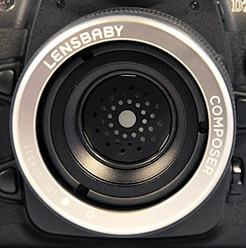
Soft Focus. Even blur with some center sharpening across a flat field.
Shooting with the $89.95 multi-coated optical glass Soft Focus lens renders any scene in a dreamy, diffused light. The center of the image is a bit sharper than the edges so centering the Composer rather than bending it is a good idea. We found it disorienting to move the sharp center around the frame simply because it wasn't dramatically sharper than the rest of the frame.
Apertures from f/2 to f/22 are provided along with three special aperture discs whose outer edge is perforated with small holes. The pattern creates a double image of a sharp underlying image with a soft overlay. You can stack a standard aperture disk on these special discs to vary the amount and the appearance of the softness. The special discs can also create out-of-focus highlights with the shape of the aperture holes. No one will be able to figure out how you did it.
The Soft Focus doublet does accept the standard Lensbaby lens cap as well as the macro accessory lenses. We shot a few images with the +10 macro lens attached with no problem.
The real value of the Soft Focus optic, for us, was in shooting faces. All we had to do was show the subject the first image and they were happy to pose for us, reversing a trend. They realized the image wasn't going to resemble Google Maps but would make them look more like Betty Davis ready for her close-up. Dreamy indeed.
You do need a bright viewfinder to focus with this optic. It can be challenging to focus manually when the image doesn't snap sharply into focus. But no real harm done if you aren't pinpoint accurate. It is a soft focus image, after all.
While we had no problem shooting all afternoon with the Fisheye, the Soft Focus optic seemed more extreme. At a birthday party, we took a few shots and switched to a prime lens. We missed the sharpness after a few glamour shots.
These two new additions to the Optic Swap System expand the Lenbaby family in exciting new ways. If you've already invested in a Composer, either of these optics makes your decision look even brighter. And if you've yet to enjoy this innovative system, there are two more compelling reasons to try it.
